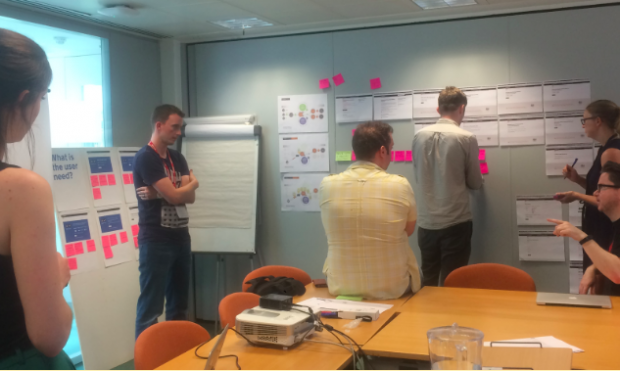
We’ve talked previously about service design and how user needs are at the centre of the GOV.UK Verify user journey. We’ve also spoken recently about how we’ve conducted a vast amount of user research, and how testing is incredibly important.
However, testing GOV.UK Verify as a standalone is not enough. Users do not access GOV.UK Verify in isolation - it is always as part of a government service’s user journey. We understand that when a user interacts with government, they want it to be quick, simple, and - importantly - seamless. So we are working with departments’ service teams to continuously develop their user journeys, and ensure that they are as smooth and as joined-up as possible.
We want to share how we’ve been doing this with DVLA colleagues, what our experiences were and what we discovered.
What we aimed to achieve
We arranged a joint service design workshop with 2 teams from DVLA focusing on service patterns. Joining our multi-disciplinary team from GOV.UK Verify and colleagues across GDS, were Lee Croucher and Paul Green from Tell DVLA about your medical condition, and Jonathan Arnold from View or share my driving licence information. It was the first time we had all come together like this, and so in order to prepare we clearly set out our aims and objectives in advance.
The aim of the workshop was to map the user journeys for DVLA services connected to GOV.UK Verify based on user needs.
The objectives were to:
- identify areas of improvement for service design
- further research within DVLA - in particular where GOV.UK Verify is integrated into a service - into areas for possible collaboration on pattern development with GDS’s experts in designing re-useable patterns and tools
GOV.UK Verify is currently connected to View or share your driving licence information (which is live) and Tell DVLA about your medical condition (which is in private beta and not yet on GOV.UK).
What we did

DVLA walked us through the user journeys for both services currently connected to GOV.UK Verify, step by step. This allowed us to clearly identify user needs as it provided context to what real people would be seeing when accessing these services.
Looking at these journeys in such detail really helped us to better understand user behaviours, and enabled us to collaborate and map out a joined-up user journey between GOV.UK Verify and DVLA’s services. This was particularly useful because, typically, when onboarding a service it’s difficult to get deep into the details which are often necessary to fully understand and identify improvements.
As a group we then mapped out the user needs for Tell DVLA about your medical condition and began to pick out potential areas for improvement. For example, GDS Service Designer Harry Trimble suggested introducing a new pattern GDS has been developing - the Check before you start pattern. This pattern could be particularly beneficial as it could help users check whether they can and should use the service according to their medical condition.
We also revisited the page that users are directed to if they have successfully verified their identity, but when DVLA is unable to initially match them with an existing record. This page sees users abandoning it more often than we'd expect, and as people have had their identity successfully verified, it was agreed this needs to be jointly investigated further by both DVLA and GOV.UK Verify.
What we found
We identified a number of next steps, and excitingly some of them are already being worked on.
One example is how users are introduced to GOV.UK Verify in the Tell DVLA about your medical condition service. The intro page within the service included a lot of content which is already provided in the GOV.UK Verify journey itself. Users don’t need to see this information twice, so we agreed we could simplify the content on the start page, limiting it to explaining why users need to verify their identity to inform DVLA about your medical condition, and letting the GOV.UK Verify journey explain how to do it. So in this joined-up approach to improve user journeys for a government service, DVLA provides the ‘why’, and GOV.UK Verify explains the ‘how’.
From the GOV.UK Verify team’s perspective, we found the workshop to be a great opportunity to thoroughly analyse a service based on context and user knowledge from both DVLA and GDS’ service design experts. Lee Croucher from DVLA has also said they fully recognise the benefits of knowledge sharing between GDS and DVLA. So for next time, they would like to open up the next workshop further to include DVLA interactive and content designers to continue our collaborative work in improving service design.
We look forward to continuing to work with DVLA on the areas identified to help make services better for users. It’s something we would definitely like to do with more services who are onboarding, or are already connected to, GOV.UK Verify.
To keep up to date with our future work with services, subscribe to the blog.
